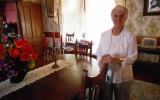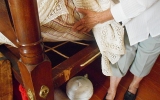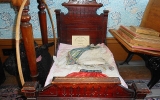Built in 1863, the Lathrop House in downtown Redwood City is one of the Peninsula's oldest and best-preserved homes.
Struck with gold fever, Benjamin Lathrop resigned a judgeship in New Orleans to seek his fortunes in California.
After business ventures in San Francisco and Sacramento, he successfully fought corrupt politicians who sought to control the Peninsula after the County of San Mateo was split off from San Francisco in 1856. He ran for and won election to become the new County’s first clerk and recorder. Later, he won election to the Board of Supervisors.
But it’s the 11-room home he and his wife built in downtown Redwood City that Lathrop is best known for today. Built in 1863 in the “Steamboat Gothic” style used in homes more commonly built in the Ohio and Mississippi river valleys, the Lathrop House serves as a living history museum on the County Center campus.
Now, after surviving two relocations, the 1906 earthquake and periods of neglect, the Lathrop House is being readied for its next chapter: a short move to a lot behind the San Mateo County History Museum at Marshall and Hamilton streets.
"The Lathrop House is a unique treasure that must be preserved," said Warren Slocum, who, like Lathrop, served as the County's clerk and recorder before his election to the Board of Supervisors. "It is so cool to walk into a home that is much the way it was a century and a half ago. Kids are blown away when they see how people lived without not just big-screen TVs but even electricity. I'm proud to play a part in keeping this house open and vibrant for generations to come."

Helen Cocco, a volunteer docent with the Redwood City Heritage Association, in the Lathrop House's dining room. The home's many features include crown molding made from redwood stained to look like oak.
The Lathrop's home originally stood on the site of the current Fox Theatre, back when Redwood Creek wound through the downtown. In 1870, General Patrick E. Connor, who served the Union in the Civil War, purchased the home for his family. In the 1890s the home was moved a short distance to make way for Central Grammar School.
Joel Mansfield, a three-term San Mateo County Sheriff, purchased the home in 1905. That year he had it relocated to its current resting place at 627 Hamilton St.
A string of owners followed. Modern amenities such as electricity, a telephone, lights and indoor plumbing were added over the years. During a housing shortage during World War II, the interior was carved into apartments.
Mitch Postel, president of the San Mateo County Historical Association, said the Lathrop House is among a small number of structures that have been preserved due to their historical signficance. These include the Woodside Store (built in 1854), Sanchez Adobe in Pacifica (built between 1842 and 1846), and the Johnson House in Half Moon Bay (built between 1853 to 1855).
To preserve the Lathrop House, the County has teamed with the Redwood City Heritage Association to restore the home with the help of private funds and operate it as a museum.
1863: What else was happening?
President Abraham Lincoln signs the Emancipation Proclamation.
Ground is broken in Sacramento for the construction of the first transcontinental railroad in the United States.
Media mogul William Randolph Hearst, industrialist Henry Ford, Archduke Franz Ferdinand of Austria and astronomer and women’s rights pioneer Annie Jump Cannon are born.
The Red Cross was founded with the creation of the International Committee for Relief to the Wounded, later to become the International Committee of the Red Cross.

Docent Helen Cocco pulls back a thin mattress to show rope supports. A chamber pot is by her feet.
The County is moving the Lathrop House to make way for a new office building that will allow the County to consolidate offices now in leased space and move employees out of older, inefficient buildings. In approving the fiscal year 2017-19 budget, the Board of Supervisors pledged $900,000 toward the move. Funding will come from proceeds of the 2014 sale of Circle Star Plaza, an office complex in San Carlos the County purchased during the recession but later determined was surplus.
On Tuesday, July 11, the Board approved a recommendation by Supervisor Slocum to allocate $10,000 in Measure K funds for architectural plans necessary to move the Lathrop House next to the History Museum and the possible addition of a carriage house, in which the museum could display horse-drawn vehicles from its 30-piece collection. County officials expect the move will take place in late 2017 or early 2018.

The dome of the San Mateo Country History Museum, which once served as the County Courthouse, is visible to the right of the Lathrop House.
It should be no surprise that a home that's been around as long as the Lathrop House has triggered many stories from those who lived in it many years ago or those who feel there is just something, well, different about it.
The house, for instance, has been visited repeatedly by ghost hunters and paranormal investigators who, according to a posting on Yelp, claim "many ghostly encounters which have been both experienced and captured with evidence."
"I've experienced it," Cocco said with a big smile. She once saw a small table move about and, just recently, witnessed a puff of smoke curl across a room where no puff of smoke had ever been seen before.
No word yet on whether County officials plan to notify any spirits about the upcoming move.
For updates on the Lathrop House move, please visit the project's website.

This original 1860s doll bed adorns a bedroom in the Lathrop House. Furniture, fixtures, tools and books throughout the home date from the late 1800s.